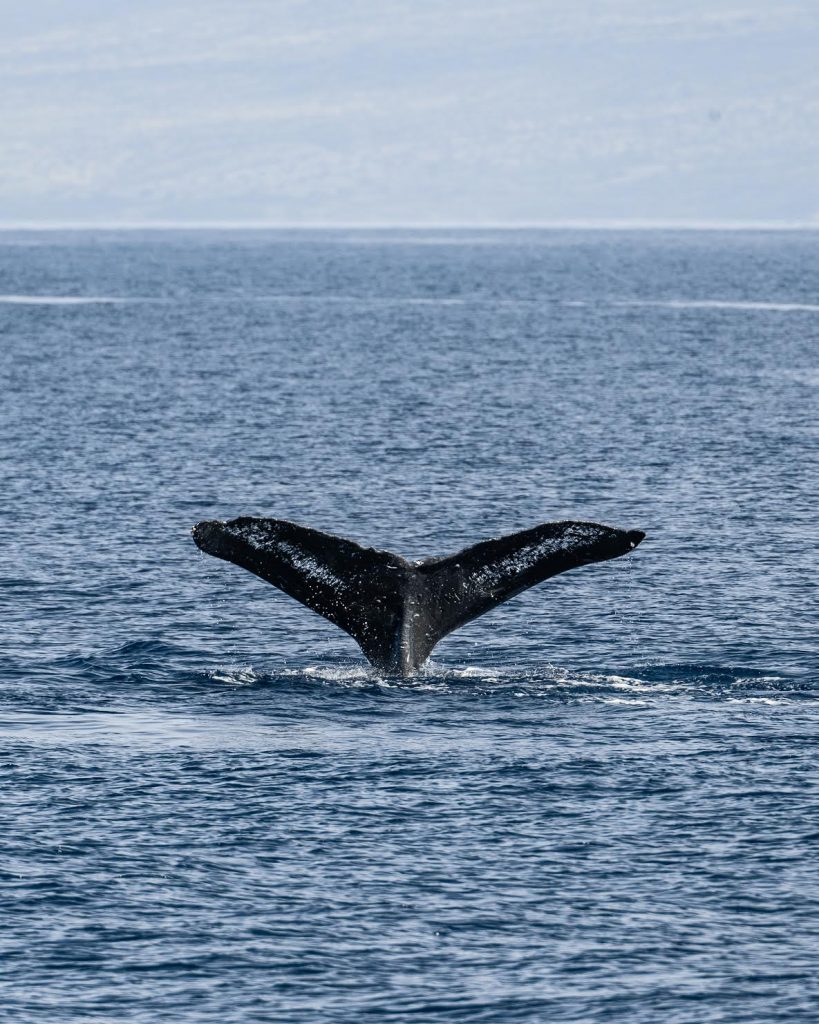Two humpback whales in Kona waters instantly identified using app with artificial intelligence
While whale watching with 39 guests on Saturday, crew members with Hawaiian Adventures Kona sited a momma, baby and male escort near Kiholo Bay.
With the app Happywhale, Capt. Andrew Aggergaard and naturalist Olivia Miller were thrilled to be able to identify the two adults by photographing their flukes and letting the app’s artificial intelligence match them to those in its global digital database of more than 70,000 whales.
Every humpback whale has unique markings on the underside of their flukes, and this mom was matched to scientific ID “HW-MN0441379” and her male companion to scientific ID is “HW-MN0441807.” The app also provided information that the female was sighted in Hawai‘i in 2021, also with a calf.
Ed Lyman, natural resource specialist with Hawaiian Islands Humpback Whale Marine Sanctuary, said tour companies like Hawaiian Adventures Kona are critical in helping scientists build the database of humpback whale flukes.
“For whale research, it’s foundational,” Lyman said. “If you can follow an animal over time and space you can get migration patterns, habitat usage and even population estimates.”
While identifying individual whales has been done since the 1970s, Lyman said this app’s artificial intelligence cuts down hours of work, often done before by two or three interns who would sit at two computer screens and compare flukes one-by-one with those in a database.
With Happywhale, the humpback now is identified almost instantly with the ever-evolving technology.
The app was created in 2015, motivated by co-founder Ted Cheeseman’s decades of expedition to Antarctica and the island of South Georgia, where 20th century whaling left oceans almost empty of the majestic creatures. But in 2011, this began to change and he began to individually identify whales, according to Happywhale’s website.
The app is meant to engage anyone interested in marine mammals and serve the research community with powerful collaborative tools.
So far, 729,203 photos of whales from around the world have been submitted to the app, with 270,380 identified encounters and 104,834 individual whales identified, according to Happywhale.
The Maui-based Pacific Whale Foundation is by far the app’s all-time top contributor, with 24,797 encounters.

Lyman said he loves the app, especially because it enables him to keep track of animals that the sanctuary detangled from derelict fishing gear.
“Once we get the gear off of it, the question is: ‘Did it survive?'” Lyman said.
Now, he often finds out that rescued animals are still alive.
The mom, calf and male escort seen on Saturday by the touring company was their first whale trio of the season. Guests watched as the calf playfully surfaced with the mom and companion watching close by.
As they cruised south the baby spent more time at the surface, while the adults took deeper dives, showing their flukes.
“We don’t always have our cameras pointed in the right direction…so it’s always very satisfying capturing a clear photo and even more so when that photo comes back as a known individual,” Aggergaard said.
Hawaiian Adventures has been contributing its fluke photos to Happywhale’s database for five years.
This time, Aggergaard said the crew and guests didn’t get a glimpse of the calf’s tail.
“While humpbacks are young they won’t raise their tails out of the water nearly as often as the adults because they don’t make as many deep and long dives,” the boat captain explained.
For identification purposes, Aggergaard said, the pigmentation and markings of a calf’s fluke will mature around 1 year old. Until then, their flukes grow so fast it is difficult to make an accurate photo identification.
So far, Aggergaard has identified 20 matches using the app and cataloged dozens more.
“We have found the more of a connection we can foster between our guests and the wildlife we encounter, the more likely our guests are to leave with a more profound respect for the world we live in,” Aggergaard said. “Telling the complete story of a humpback using photo identification is a great way to build that connection.”
Sponsored Content
Comments














